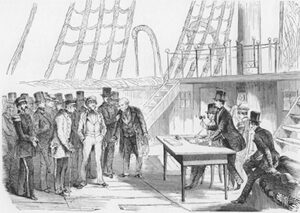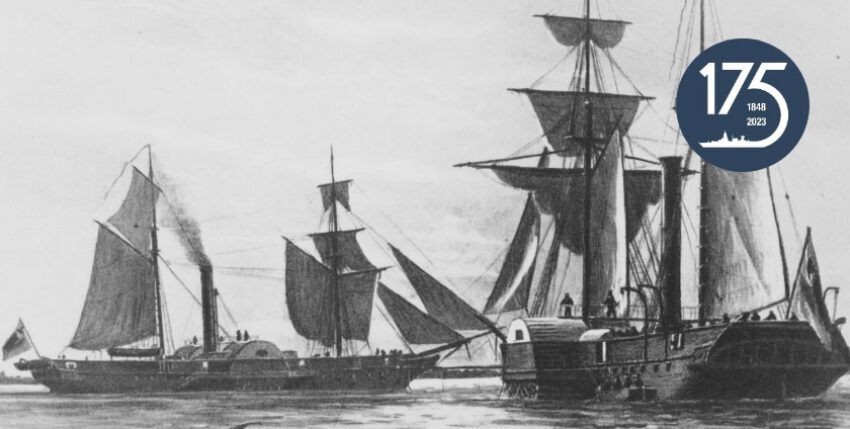The German Navy is celebrating its 175th birthday. But the road to peace and freedom was long and full of upheavals.
On 14 June, the German Navy celebrates its 175th birthday. Well, you might ask yourself. Historically, due to the end of the Second World War and the subsequent new beginning, the Bundeswehr - and therefore also the navy - only celebrated its 65th birthday a few years ago. So where did 170 years come from? The answer is rather complex and requires a reading of German history books on the past two centuries.
At the beginning of the 19th century, the political situation in Europe was characterised by the recent French Revolution and the subsequent Napoleonic era. After Napoleon's abdication in April 1814, the Congress of Vienna met from September 1814 to June 1815 with the aim of reorganising Europe after the Wars of Liberation. Based on a free and liberal idea and the hope of a nation state for all of Germany, the result for the more than 40 German kingdoms, principalities and free cities was the formation of the German Confederation, a loose confederation of German nation states. The kings of Great Britain, the Netherlands and Denmark were also members, as they also had territories on German territory. The German Confederation was burdened from the outset by the rivalry between the Austrian Empire and the Kingdom of Prussia for the leading role, but nevertheless lasted until the German War in 1866.
With increasing industrialisation in the first half of the 19th century, trade by sea also experienced a noticeable upswing. The North German states in particular operated a large merchant fleet. However, only the foreign member states Great Britain, Denmark and the Netherlands had naval forces to protect merchant ships in the area of the German Confederation. Of the German states, only Austria and Prussia had a fleet, but both were of no real significance. There were repeated calls for the establishment of a German navy, but they all went unheard. It would be years before this changed.
The birth of German naval history
The February Revolution of 1848 in France triggered political unrest throughout Europe. A number of conflicts that had previously been smouldering underground broke out openly, including a dispute between the Kingdom of Denmark and the two duchies of Schleswig and Holstein. Holstein was part of the German Confederation, while Schleswig, which was populated by both Germans and Danes, was not. At the heart of the dispute was the question of whether Schleswig-Holstein - according to an earlier agreement from 1460, both duchies were to remain "eternally undivided" - belonged to the German Confederation and a later German nation state or to the Kingdom of Denmark. The dispute known as the "Schleswig-Holstein Uprising" escalated and led to the First German-Danish War in March 1848. The Danish fleet immediately began a blockade of the German coasts, capturing several dozen German merchant ships and bringing German trade by sea to a virtual standstill. The lack of any naval forces to protect the defenceless merchant ships on the German side became painfully apparent and calls for a navy of their own were once again heard. Against this backdrop, on 14 June 1848, the German National Assembly in Frankfurt's Paulskirche resolved to set up its own navy. Six million Reichstaler were made available for the construction of the ships. In the end, the fleet, known as the Reichsflotte or Bundesflotte, consisted of 27 rowing gunboats and twelve larger warships, several of which were already steamships. All flew the black, red and gold flag - the first German navy was born. At the same time, the Kingdom of Prussia continued to expand its existing small navy, but kept it under its own control and authority due to internal tensions within the German Confederation.
It should be mentioned in passing that, in view of the conflict with Denmark, the people of Schleswig-Holstein also set up their own small fleet, independent of the all-German federal fleet. This fleet achieved some notable successes against the superior Danish fleet, but is also of particular importance due to two technical innovations. The steam-powered gunboat Von der Tann not only had a new and very powerful propulsion system, but was also one of the first seagoing vessels to be propelled by a propeller rather than a paddle wheel, which was a technical revolution at the time and subsequently became established everywhere. At the same time, the Brandtaucher, the first ever functional submarine, was built. Although it sank during the first diving attempt in the Kiel Fjord, this was not due to the design, but merely to poor construction. Inventor Wilhelm Bauer was able to rescue himself and his team from the sunken boat and further develop and perfect his idea. This first attempt to build a submarine is the origin of all further developments up to the present day. The original of the fire diver, recovered from the bottom of the Kiel Fjord 36 years after its loss and restored, is now on display in the Military History Museum of the German Armed Forces in Dresden.
End of the Imperial Fleet
The Imperial Fleet was able to achieve some minor successes in the conflict with Denmark, but never gained any real significance. The only encounter with the Danish fleet was the battle of Heligoland on 4 June 1849, which was ultimately broken off without result. After the end of the war with Denmark and the failure of the first attempt to proclaim an all-German nation state, the Bundestag decided to disband the fleet. On 31 March 1853, the disbandment order was issued - after some of the ships had already been handed over to Prussia or auctioned off and the crews had been dismissed - and the first German navy was already history again after only around five years.
The Prussian navy remained in existence. It was further expanded to protect Prussian interests, survived further political developments and, after the war against France in 1871 and the subsequent founding of the German Empire, formed the nucleus for the formation of the Imperial Navy. In view of the newly emerging naval, colonial and world power ambitions, it was expanded into a powerful high seas fleet in a veritable arms race with Great Britain. After the end of the First World War and the end of the monarchy, Germany was still granted a navy during the Weimar Republic, but the strength of the Reichsmarine was considerably reduced. After the National Socialists came to power in 1933, the navy became the Kriegsmarine and was once again heavily rearmed. The end of the Second World War also signalled the end of the navy. For around ten years afterwards, there was no navy at all in Germany, apart from several thousand former German marines who cleared a large number of sea mines in the North and Baltic Seas under Allied command for a few years.
Black-red-gold
The period from the dissolution of the Imperial Fleet in 1853 to the end of the Second World War in 1945, which is only briefly touched on, basically combines four eras of different navies of German nations - none of which expressly belong in the historical and traditional understanding of today's navy. They all flew different flags - but none of them in the colours black, red and gold. For the sake of historical fidelity, however, it must be noted at this point that these colours were also those of the Weimar Republic and could also be seen in the Gösch, a small "window" in the upper left corner of the flag of the Reichsmarine. However, this circumstance was short-lived and rather insignificant due to the political currents of the time and the two major world wars. The black, red and gold flag only experienced a renaissance in the mid-1950s with the formation of the Bundeswehr and Bundesmarine mentioned above - and for the sake of completeness also the National People's Army and the People's Navy of the GDR.

1848 survey, illustration: Archive German Naval League
The flag in the colours black, red and gold goes back to the aforementioned wars of liberation of the Napoleonic era at the beginning of the 19th century. One of the units of the Prussian army was the Lützow Freikorps, which consisted not of regular soldiers but of superficially trained volunteers, basically civilians, who took part in the battles, driven by a liberal-liberal conviction and enthusiasm for an all-German nation state. Only black cloth was available for their uniforms. The frock coats sewn from it were decorated with red lapels and gold-coloured buttons - and a uniform in black, red and gold was complete. Since then, the colours have been regarded as a symbol of a free and liberal basic idea and a German republic. They were later also used in the flag, which in 1848 was officially declared the flag of the German Confederation by the Bundestag - and thus also of the federal fleet.
At this point, we have basically come full circle. The strong popular will for an all-German nation state may have failed in 1848 due to resistance and the power of the authorities, but the Reichsflotte, which was created almost simultaneously, was an all-German navy controlled by parliament with the attribute of alliance capability. The Imperial Fleet only had a short lifespan, but it has a number of parallels to the present day. The visible and unifying element is the black, red and gold flag. In this respect, today's navy of the Federal Republic of Germany sees itself in their tradition and for this reason was given the name German Navy again in 1995, some time after German reunification. A few years later, on 14 June 1998, the 150th anniversary of the former parliamentary resolution from the Paulskirche in Frankfurt was celebrated officially as the 150th birthday of the navy. Since then, this day has been celebrated every year as the Navy's birthday - this year for the 175th time.
Why the German Navy?
Even though it has already been explained, I would like to take another brief look at the question raised at the beginning about the name of our present-day navy. The conflict that divided the victorious powers into two camps was already evident at the end of the Second World War, which manifested itself within a few years as the division into the two large blocs of East and West and also as the division of Germany. NATO and the Warsaw Pact were founded, both parts of Germany were integrated into the respective blocs and given their own armed forces again. The Bundeswehr was formed on the western side from the mid-1950s, while the Nationale Volksarmee (National People's Army), usually referred to as the NVA for short, was formed on the eastern side. Both were also given a maritime component, the naval police, from 1960 the NVA's People's Navy in the East and the naval forces of the Federal Republic of Germany in the West; the latter was known in common parlance for several decades as the Bundesmarine.

are auctioned, illustration: Archive German Naval Association
With the end of the Cold War, the previously divided Germany was reunited and became the Federal Republic of Germany. The GDR ceased to exist and with it the National People's Army. Parts of the personnel of the Volksmarine of the NVA were integrated into the Bundesmarine; otherwise this was also history and there was only one navy in the reunified Germany. This paved the way for a return to the development described above in the middle of the 19th century. In 1995, the Navy of the Federal Republic of Germany officially became the German Navy. Unfortunately, this renaming is comparatively little known, which explains why even today, more than 25 years later, the name Bundesmarine is still used as a matter of course in many publications, even though it has been called Deutsche Marine for a good quarter of a century.
Former frigate captain Achim Winkler is a former press officer in the German Navy.
Achim Winkler










